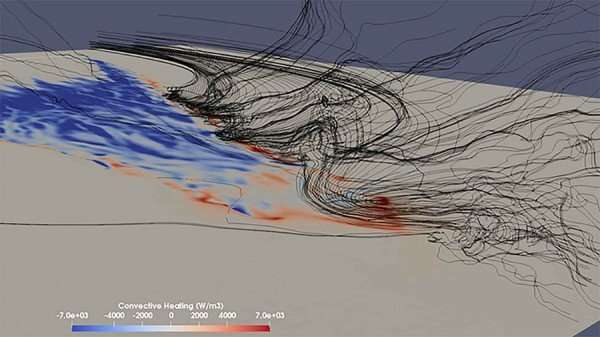Fluid dynamics provides insight into wildfire behavior

The Kincade Fire has been burning through Sonoma County, California, displacing people from their homes and leaving destruction in its wake. It is a stark reminder of the increasingly pressing need for a better understanding of how fires begin and spread.
This is where Rodman Linn and his research come in. He develops and uses computational models of the coupled interaction between the wildfires and surrounding atmosphere at Los Alamos National Laboratory. In the November 2019 issue of Physics Today, Linn describes a few of the many ways that fluid dynamics controls the behavior of fires.
It's incorrect to view wildfires as advancing walls of flame, as they often are conceptualized. The movement and behavior of fires are far more complex.
"The buoyancy caused by the energy release of the fire itself interacts with the ambient winds to produce complex patterns of air movement that dictate the fire's behavior," said Linn, a senior scientist at Los Alamos National Laboratory.
The main way wildfires spread is through the motion of hot gases caused by ambient wind pushing air through the gaps between the towers of flame created by updrafts.
"The fluid dynamics that's controlling the wildfire has a wide range of scales," said Linn. "It's everything from the movement of hot or cold air around foliage up to the weather patterns and topography-induced movement of air. That wide range of scales and sizes of fluid dynamics structures is part of what makes wildfire prediction so challenging."
A part of mitigating the devastation caused by wildfires is understanding how fire interacts with the surrounding environment, so people can make better decisions on evacuation plans and how structures are built.
"The decisions that fold into the human piece of lessening wildfire destruction depend on understanding current and future wildfire behavior under a wide range of conditions," said Linn.
Another way to manage wildfire is through controlled burns, which are purposeful, strategic fires set by land managers. It's a practice currently being used successfully in the southeastern United States but dates centuries back to Native American nations. The trees in overgrown forests provide excess fuel for wildfires to spread. By setting prescribed fires at regular intervals to clear out overgrowth, which depends on the local ecosystem type, the risk of catastrophic fires can be lowered.
Prescribed fires are carefully controlled using complicated ignition patterns that are based on local vegetation, topography and weather conditions.
In order to bring this practice successfully to the western portion of the country, it is necessary to use research being done by Linn and others in organizations, like the USDA Forest Service and Tall Timbers Research Station, to understand how the different environmental conditions influence how the fire behaves. Through this kind of research, scientists hope to enable practitioners to confidently tailor prescribed fire tactics to a wider range of scenarios and increase their ability to adapt to dynamic conditions.
More information: Rodman Linn. Fluid dynamics of wildfires, Physics Today (2019). DOI: 10.1063/PT.3.4350
Journal information: Physics Today
Provided by American Institute of Physics



















